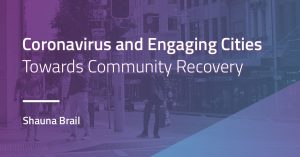Coronavirus and Engaging Cities:
Towards Community Recovery with Sally Hussey

Sally Hussey | Principal Writer and Editorial Director, Granicus
Can we re-imagine a collective urban future beyond the pandemic? Coronavirus and Engaging Cities: Towards Community Recovery, the latest ebook by urban scholar Shauna Brail, PhD, provides a positive pathway for urban-led local recovery and magnifies the generational opportunity to re-imagine – and engage – cities, urban spaces and communities.
Cities are at the epicentre of the coronavirus pandemic. COVID-19’s impacts on densely populated urban centres, moreover, have redoubled the inequalities of urban cities as it has become evident that groups are affected unequally. Most particularly, vulnerable and marginalised communities. And, while global lockdown has forced many changes – social distancing, quarantining and self-isolation measures to curtail person-to-person transmission – the move to re-opening is overwhelmed by complexity and uncertainty.
Indeed, while there are disquieting historical parallels to previous epidemics, there are also evidence-based arguments for the conjoining of cities and disease. Early urban planning laws, for instance, sought to minimise exposure to infectious disease where the regulation of street layout, building codes and public space standards tackled overcrowding and poor sanitation of the industrialised city.
Coronavirus and Engaging Cities: Towards Community Recovery, the latest ebook by urban scholar Shauna Brail, PhD, highlights the potential of positive change arising from the pandemic as it provides “pause to force a collective rethinking of priorities.” That is, it provides an opportunity to reconceive a collective urban future that prioritises equity considerations for marginalised and other equity-seeking groups. “Coronavirus reveals weaknesses in cities,” writes Brail, “Yet at the same time, this is a generational opportunity to reimagine cities and urban spaces.”
Brail draws together common challenges currently facing cities across the globe and urban-level approaches that characterise municipal responses to rebuilding and engaging communities beyond the coronavirus pandemic. Expanding on opportunities for community recovery in four key areas – mobility, housing and food security, local business and public realm – she charts the move from lockdown to reopening and magnifies areas for ongoing public engagement.
Critical is Brail’s attention to the pivotal role of municipal governments. Local authorities are crucial to not only rebuilding economies but communities. And although local governments can seem less powerful in decision-making, positioned in the shadow of federal government policy, she appraises the rapid municipal-led responses to the pandemic that “demonstrate the role that city governments can play as catalysts in supporting residents’ basic humanitarian needs.” Crucial to this is community engagement. As she emphasises, “the overarching prioritisation of people emerges throughout each of the four key areas and is fundamental to all city building.”
Brail’s research into the prioritisation of social infrastructure and community engagement is not without precedent, however. In the 2018 publication Citizen Engagement and the Changing City, my previous collaboration with Brail, she addressed questions around twenty-first-century city-building, bringing into question the very concept of the ‘liveable city’ and how to tackle patterns of inequality. “Is it possible,” she asks, “to build a liveable city without collaborating with the very communities that will live in them?” Not only do inequalities shape twenty-first century urbanisation, but they act as a querulous warning for future city-building, where gentrification of lower-cost neighbourhoods suggests an increasing emphasis on spaces for an urban elite at the exclusion of diversity. Identifying that without community engagement, city-building violates the very sense of community itself, here she offers a practicable approach to meaningful citizen engagement. Distilling her research across North America, the UK and placemaking initiatives in India, she provides a tangible approach to city-building and planning that prioritises social infrastructure, meaningful neighbourhood opportunities and leverages the prosperity of large-scale institutions.
Providing strategies for rebuilding in Coronavirus and Engaging Cities not only confronts the unequal impacts of coronavirus, however. Consultation and engagement, Brail writes, “is essential in facilitating rebuilding. Engagement mechanisms that enable the sharing of knowledge, insight and needs are crucial to developing responsive and flexible recovery and rebuilding strategies.” Here, she specifies that experimentation and collaboration walk hand in hand.
While Brail herself argues it is too soon to understand the full impact of the pandemic, providing a lens on four strategic pathways to community recovery, we gain insight into collective challenges – particularly where COVID-19 has amplified homelessness, overcrowded living arrangements, underemployment and food insecurity. But we don’t lose sight of the generational opportunity to address key aspects of urban and community life going forward.
Coronavirus and Engaging Cities: Towards Community Recovery is freely accessible to download at Granicus.
 Author Bio: Sally Hussey is Granicus’ Principal Writer and Editorial Director, where she interrogates global challenges in public engagement and commissions evidence-based research by experts to inform the wider community on insights into global issues in public engagement. She has an extensive background in the publishing, academic and cultural sectors. She is also recognised by the Who’s Who of Australian Women.
Author Bio: Sally Hussey is Granicus’ Principal Writer and Editorial Director, where she interrogates global challenges in public engagement and commissions evidence-based research by experts to inform the wider community on insights into global issues in public engagement. She has an extensive background in the publishing, academic and cultural sectors. She is also recognised by the Who’s Who of Australian Women.
